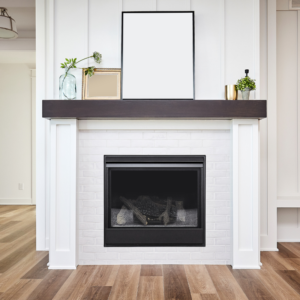Fireplaces are a well-loved feature in many homes, prized not only for adding heat but also ambiance that makes a house feel inviting, stylish, and comfortable. And while traditional wood fireplaces have long been the standard go-to, gas-fueled systems have emerged as a convenient alternative that increasingly mimic the benefits of wood burning appliances – and feature a host of benefits of their own.
If you’ve been dreaming of adding a fireplace for a long time, are considering a system upgrade, or have just started entertaining the possibilities of what a fireplace or stove could add to your home, you’re in the right place. There are a world of possibilities out there for enhancing and enjoying your home – regardless of what kind of system you choose. Let us help you in your home improvement process by taking a moment to weigh the pros and cons of gas-fueled systems.
What Are the Pros of Gas-Fueled Appliances?
✓ Convenience
 If we’re going to start with the pros, why not lead with one of the biggest ones? Gas fueled appliances are easy to use. While wood fires require gathering, splitting, and storing wood, starting a fire, tending to it throughout the burn, then waiting for it to die down (so as not to leave it unattended), gas fireplaces only require the flick of a switch. This makes it an ideal choice for homeowners who want to enjoy the ambiance of a fire without the hassle of a traditional fireplace.
If we’re going to start with the pros, why not lead with one of the biggest ones? Gas fueled appliances are easy to use. While wood fires require gathering, splitting, and storing wood, starting a fire, tending to it throughout the burn, then waiting for it to die down (so as not to leave it unattended), gas fireplaces only require the flick of a switch. This makes it an ideal choice for homeowners who want to enjoy the ambiance of a fire without the hassle of a traditional fireplace.
✓ Cleanliness
Wood fires produce ash and smoke, which condenses as it cools, leaving creosote on the chimney walls. These byproducts can make a mess and require regular cleaning and sweeping to keep the system functioning safely and optimally. Gas fireplaces, on the other hand, produce no ash or smoke, minimizing the cleaning and maintenance needs required. Most years, all the maintenance that will be required is your annual professional inspection.
✓ Safety
Generally speaking, gas fueled systems are considered safer than wood burning ones. Because no real wood is used, there’s no risk of sparks or embers escaping onto the roof or into your living space and potentially starting a fire. Gas fireplaces can also be switched off quickly in emergencies.
✓ Efficiency
Gas fireplaces run very efficiently. They burn more cleanly than wood-burning appliances and lose less heat up the chimney – meaning more heat generated by the fire stays in the room. Additionally, the heat output of a gas unit can be controlled more precisely than a wood one.
✓ Customization
You tend to have more options as to where a gas fireplace or stove can be placed, particularly because there are both vented and ventless options. They can be installed with minimal construction alterations or fitted into an existing system, and they offer a lot of flexibility in where they can be placed within any given room. Additionally, there are many different “looks” available in a variety of finishes. So whether you want something sleek and modern or a more traditional look, you’re likely to find what you’re looking for.
What Are the Cons of Gas-Fueled Appliances?
✖ Cost
If you’re lucky enough to be able to chop your own firewood, you’ll be able to fuel a wood burning fireplace less expensively than one that uses natural gas. You’ll also be reliant on a continuous supply of natural gas to use your fireplace, so if you experience a disruption in supply you won’t be able to rely on your fireplace to provide heat during the outage.
✖ Ambiance
A wood fueled fire gives a total sensory experience – the engaging scent of burning wood, the crackling sounds, the warmth of radiant heat on your skin, and mesmerizing, unpredictable visual of flame patterns as logs break down over time and embers glow. Gas fires do produce warmth, but flames are often smaller and less vibrant than wood fires.
✖ Experience
Just as many find the ease of enjoying a fire at the flip of a switch to be a significant advantage of gas-fueled units, others may feel that the hands-on, time-involved process of building and tending a fire is all part of relaxing and enjoying a fireplace.
Fireplaces, Inserts, and Stoves: Which Is Right for Me?
When you’ve decided on the fuel source that works best for you, you’ll find there are other categories to consider. What’s the difference between a fireplace, insert, and stove? Each of these offers its own pros and cons, but most simply, they can be thought of this way:
 Gas fireplaces are standalone units typically installed in rooms without an existing fireplace. They can be vented (meaning they require a chimney) or ventless (able to be installed without a chimney). These can cost a bit more to install, but typically provide the most options affecting ambiance and design.
Gas fireplaces are standalone units typically installed in rooms without an existing fireplace. They can be vented (meaning they require a chimney) or ventless (able to be installed without a chimney). These can cost a bit more to install, but typically provide the most options affecting ambiance and design.- Gas inserts are made to be installed into an existing fireplace. Because a chimney is already in place, inserts are typically less expensive to install than fireplaces and are a convenient way to convert a wood-burning fireplace to gas.
- Gas stoves are small and free-standing, offering a great deal of flexibility for placement. They provide direct radiant heat and are a highly efficient option for homeowners wanting to bring the warmth in a big way.
We Offer Quality Products – Call Today
Regardless of what you decide about unit type and fuel source, you’ll be pleased at what we have to offer, both in terms of the products we install and the expertise and service with which we install it. If you’re ready to learn more, we’d encourage you to reach out – we’d be delighted to hear from you!

Recent Comments